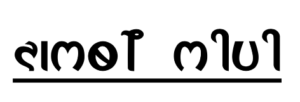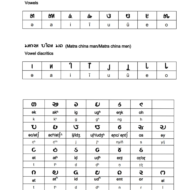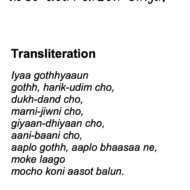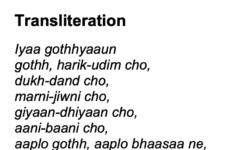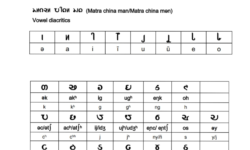Profile
Since the end of World War II, no country in the world has seen the invention of more indigenously-created scripts than India. At least 40 have been created, mostly by self-taught linguists working alone on behalf of their community. Some have been accepted and adopted to a remarkable degree; others are sustained by only a handful of devotees. A good case study is Halbi.
About 700,000 Halbi live in Chhattisgarh, India; more are scattered across Odisha,
Madhya Pradesh and Maharashtra. The Halbi language is widely used as a trade language in central India, but Halbi culture has traditionally been oral, and has been written largely in the Devanagari script because Hindi is the official language of Chhattisgarh state. Over the past 25 years, though, Vikram Soni, a district and sessions court clerk in Jagdalpur who holds a master’s degree in history, has been developing a script specifically for Halbi.
In an interview with Mahendra Kumar Mishra of the Folklore Foundation of India, Soni explained his reasoning and method for creating the new script.
“In the beginning I wanted to use Devanagari script for Halbi, but I found that Devanagari and other syllabic scripts aren’t sufficient to write the actual pronunciations of Halbi words.”
In addition, there was the problem, common in minority languages spoken over a widespread area, that multiple scripts were being used, resulting in confusion and mutual unintelligibility.
“Some dialects related to Halbi are spoken in Odisha and Andhra Pradesh. The speakers of these dialects use Oriya and Telugu scripts to write their dialects. That is why Halbi speakers of various states couldn’t communicate in writing with each other.”
Finally, there was the question of gaining self-respect in what has been traditionally an oral culture.
“Another purpose of creating Halbi script is to generate self-respect and to promote writing and reading in Halbi amongst the Halbi speakers.
“I studied many syllabic and alphabetic scripts of Asia, Europe and Africa. I also studied about characters/glyphs of the scripts invented in the last century. I felt a need of a new alphabetic script for Halbi. In 1996, I roughly created a new script which was totally different from this script. I worked on this formula:
- The glyphs of Halbi letters should be modified forms of Devanagari letters, so that the people who know Devnagari script, can learn it easily.
- Each glyph of the letters and diacritics should be simple, drawn and written in a single stroke. That will make it easy to write quickly.
- The script should have a single type of letters for both handwriting and printing, not like Latin and other European scripts.
- Consonants, vowels and vowel diacritics should be written as these appear in the pronunciation in a word.
- Each consonant should be written everywhere as it is, but for nasal consonant there should be option to write an anuswar sign (a point sign) like other Indic scripts.
“Finally, I created the Halbi script in 2006. I used this script to write all the things in Halbi for a year and discussed with Halbi writers and speakers. After that in 2007, I redesigned the glyphs.
“I searched for font makers in India and abroad, but nobody helped me. In 2010 Dheeraj Das, a young man who was a resident of my hometown, met me and proposed to make fonts for the Halbi script. He kept his word. Now, he is a good friend of mine.”
In an email to the Endangered Alphabets Project, he went on: “It took a long time to get this script adopted. Halbi speakers think their language, Halbi, has no importance in employment, education, or social status, [and] for these reasons they want to learn Hindi or English.
“It is very hard to make Halbi speakers understand how important their mother tongue is to preserve their culture, traditions, and knowledge received from their ancestors.”
The script is not widely used, though some books were published by the Halba society of Balod and Kanker district of Chhattisgarh.
“I distribute typed booklets regularly to the people to learn Halbi script. There isn’t any publication using it, but two books (a collection of Halbi stories written by me and poems written by Mr. Narendra Padhi) have been published in the Halbi script this year [2021].”
You can help support our research, education and advocacy work. Please consider making a donation today.
